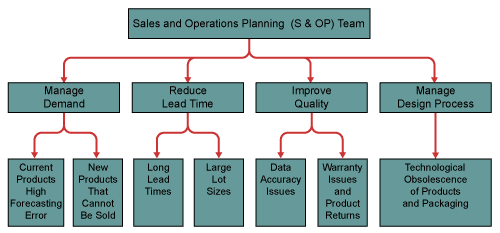
© "DHL Logistics - MAN truck" by Peter Mooney is licensed under BY-SA 2.0.
Key Points
- Lean Six Sigma can reduce waste in any corporation.
- Taking a closer look at the high and low level causes of supply chain issues can illuminate where issues are.
- Proper usage of LSS techniques can lead to a reduction and remediation of any supply chain issues.
Excess and obsolete inventory write-offs are chronic supply chain problems costing businesses billions of dollars each year. Unfortunately, improvement projects that are deployed to eliminate these problems often have a short-term focus. In other words, the current levels of excess and obsolete inventory are usually addressed, but not the root causes of the problem.
Often such inventory is reduced by selling it below standard cost or donating it to charitable organizations. Competing business priorities sometimes keeps businesses from developing effective long-term solutions to eliminate the root causes, sometimes it is the difficulty in unraveling the complexity of the root causes.
Lean Six Sigma methods have been shown to be very effective in finding and eliminating root causes, and thus preventing arbitrary year-end reductions in inventory investment.
Higher- and Lower-Level Root Causes
An analysis of excess and obsolete inventory often shows that its major root causes are associated with long lead times, poor forecasting accuracy, quality problems or design obsolescence. However, these higher-level causes can be successively broken down into lower-level root causes as shown in the figure below.

As the figure suggests, from an inventory investment perspective, a long lead time may be caused, in part, by large lot sizes. For example, if the actual lead time or order cycle time is 30 days, but the required lot size for purchase is 90 days of supply (DOS), then this lot size drives a higher average inventory level than lead time by itself. In this case, the average on-hand inventory (neglecting a safety-stock calculation) increases from 15 to 45 DOS assuming a constant usage rate.
Of course, the actual reasons for large lot sizes would have to be investigated by a Lean Six Sigma improvement team. The root causes of long lead times also could be due to complicated processes having numerous rework loops and non-value-adding operations as well as scheduling problems and/or late deliveries.
The second major cause of excess and obsolete inventory is poor demand management practices. Some lower-level root causes may include inaccurate historical demand data, a poor forecasting modeling methodology or other issues such as overly optimistic sales projections.
Lean Six Sigma projects also can be used to attack lower-level root causes in this area. Lean Six Sigma is frequently used to improve quality levels to reduce waste and rework caused by a multitude of diverse factors within a process workflow. Finally, Design for Six Sigma can be used to improve the design processes for new products or services.
Using DMAIC to Find Root Causes
Lean Six Sigma improvement teams can drive to the root causes of their excess and obsolete inventory problem using the DMAIC problem-solving methodology (Define, Measure, Analyze, Improve, Control) in conjunction with Lean tools as well as process workflow models.
In fact, building simple Excel-based inventory models or using off-the-shelf software, are good ways to identify the key process input variables (KPIVs) or drivers of excess and obsolete inventory problems. Inventory models follow a generalized Six Sigma root-cause philosophy – Y = f(x).
They also are effective communication vehicles showing sales, marketing, manufacturing and other supply chain functions, as well as the impact of lead time and demand management practices on excess and obsolete inventory.
In an actual improvement project, the team begins an inventory analysis by defining the project’s goals in the Define phase. Using these goals as guidelines, relevant questions are developed to enable the team to understand how the system operates.
Streamlining Your Supply Chain
Data fields corresponding to these questions are identified and extracted from information technology (IT) systems. The data fields are then organized in the form of an inventory model to provide the information necessary to answer the team’s questions and understand the root causes of the inventory problem.
After the Define phase, the team begins to evaluate measurement systems and plan data collection activities. This is the Measure phase of the project. An important activity in this phase is an on-site physical count by location of inventoried items associated with the problem.
This is done to measure valuation accuracy relative to stated book value. Measurement analyses also are conducted of management reports and their related workflow systems.
These analyses determine the accuracy of key supply chain metrics such as lead time, lot size, expected demand and its variation, forecasting accuracy (different from demand variation), on-time delivery and other metrics that may be related to an inventory investment problem.
Making Sense of the Data
Unfortunately, supply chain metrics often are scattered across the several software systems within an organization. These systems include the forecasting module, master production schedule module, materials requirements planning module, inventory record files, warehouse management system module and similar IT systems.
After verification of a system’s metrics, the improvement team begins data collection to capture information necessary to answer the team’s questions developed during the Define phase.
Relevant information, which may help the team in its root-cause investigation, usually includes suppliers, lead times, expected demand and its variation, lot sizes, storage locations, delivery information, customers and other facts.
Analyzing Data and Using Inventory Model

The Analyze phase begins after the required data has been collected and a simple inventory model has been created using classic inventory formulas such as those found in operations management textbooks. These models are used to analyze an inventory population to understand how key process input variables impact excess and obsolete inventory investment (i.e., key process output variables).
A value stream map also should be constructed as part of the overall analysis. In fact, in many projects, a value stream map, once quantified, becomes the basis for the inventory model. This is especially true when the analyses focus on internal process workflows, at system bottlenecks, rather than finished goods inventories.
In addition, a simple inventory balance is calculated for every item and location of the inventory population based on each item’s service level, lead time and demand variation.
An inventory balance shows which items and locations may have too much inventory and which items and locations may have too little inventory. In the latter case, inventory investment must be temporarily increased to meet required customer service levels.
After the team determines the root causes of the excess or obsolete inventory problem, it develops countermeasures to eliminate these root causes – the project’s Improve phase. In addition, other needs for improvement may be found as a project winds toward the Improve phase.
The Analyze phase often identifies other types of process breakdowns within the supply chain that may serve as a justification for subsequent improvement projects. Lean tools and methods are particularly important in the analysis and execution of these types of projects. In fact, the application of the Lean tool, 5S, or what can loosely be called housekeeping, in the Control phase of a project, can help ensure that the resultant improvements are sustained over time.
Is Lean Six Sigma the Right Choice for You?
When it gets down to it, your organization is probably better off implementing the LSS methodology. It isn’t just a means of reducing waste and inefficiency at the supply chain level, but rather something that transforms an entire organization. As such, it is certainly worth considering making the switch if you’re unhappy with your current workflow.
Other Useful Tools and Concepts
Looking for some other way to bolster your supply chain? Learning how to build a win-win supply chain is a net benefit for you and your suppliers. Our guide covering the issue covers how to best implement it in your organization.
Further, you might want to take a closer look at effective supply chain management. The modern business is a complex thing, and learning how to best manage your supply chain is going to prevent headaches down the line.
Conclusion: The Typical Project Benefits
Typical benefits of defining and implementing improvement projects to reduce and eliminate excess and obsolete inventory include higher system accuracy, creation of quantified inventory models showing relationships between inventory investment versus lead time and demand variation, higher inventory valuation and location accuracies, higher cycle counting accuracies, and – most importantly – permanent reductions in excess and obsolete inventory investment.
The image featured at the top of this post is ©"DHL Logistics - MAN truck" by Peter Mooney is licensed under BY-SA 2.0..